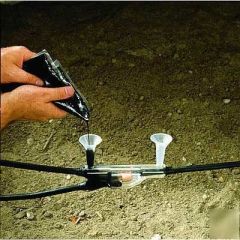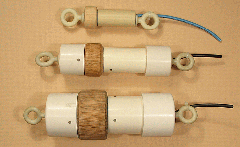DC Amp Clips & Current Clamps by Swain Meter

80" diameter current clamp
Overview
MER2™ DC Amp Clips and Clamps are "Swain Sensors" which precisely detect the magnitude and direction of direct current flowing on magnetized conductors during normal operation without interrupting the circuit. Swain portable DC amp clips for cathodic protection above ground and sub sea are manufactured from ¾ to 6" in diameter. Swain clamps are two piece sensors manufactured from 6" to 54" in diameter. Larger clamps may be built upon request.Clamps are manufactured in 4 piece sections for sizes greater than 54".
Features
- MER2™ (Magnetic Error Reduction doubled) type DC Amp Clips are generally more accurate for measuring direct current with a non-contact sensor. They are constructed to reduce errors due to non-uniform magnetic fields common on steel pipe, near rebar, or near the battery in cars and trucks. Zero offset error is generally less than one quarter that of comparable standard Swain Meters.
- Typical accuracy is ± 1% reading, ± 3 digits, ± He. User friendly 31/2 digit LCD meter with polarity & 1/2" high numerals.(He is zero offset sensitivity of the sensor to the earth's magnetic field. The earth field is uniform unless steel is close and distorts it. A strong magnet nearby can also cause zero offset.)
- Protected from 300 A overload.
Capabilities of DC Amp Clips & Clamps
-
Suitable for use in high-noise environments of power plants.
-
Currents in URD concentric neutral, pump shafts, and transmission pipe can be measured while in service.
-
Differential leakage current, even current flowing inside steel conduit, may be measured.
-
Interference current can be recorded using a recorder jack which multiplies the unattended meter span by up to 5 times.
-
If two or more conductors are in the aperture of a sensor, the reading is the algebraic sum of all currents.
-
The indicator shows the average magnitude of current whether it is DC, pulsating, AC, or a combination.
-
Alternating current is rejected so that 10 amp. AC interference will change a measurement less than 5 mA.
-
A brief 200A overload on any range will not alter the zero or damage the meter.
-
Accuracy is good even if a conductor is not centered in the aperture of the sensor.
- Current flowing outside the sensor is rejected.
Measurement Examples
-
Car battery current with the cable connected normally. Parasitic drain, charging and cranking current are shown without the need to disconnect a cable.
-
Power plant battery float charge and load current with the battery on line and connected.
-
4-20 mA loop current with the control on line, with no need to break the current loop.
-
Sacrificial or impressed anode current by clipping around the cable. No need to open the cable or add shunts which would increase resistance and could blow with lightning. Likewise with bonds.
-
Interference current in a large gas pipe, steel reinforced concrete column, or telephone cable with the line in service.
-
Flange leakage current in an operating gas, oil or water pipe.
-
Foreign contact or ground faults are located when other devices fail.
-
Offshore platform aluminum anode current at depths of hundreds of feet to show that electrical contact is good and the anode will last.
-
Current in a propeller or pump shaft while the shaft is rotating.
-
Guy wire or anchor rod current drain to ground when only a short section is handy.
-
Electrolytic current flowing in brine in a pipe or in salt water.
-
Algebraic sum of current in a steel conduit plus the current in conductors inside the conduit by clipping over the outside of the conduit.
-
Differential control line leak to ground and fault location with the line operating.
-
URD bare outer conductor resistance to find local corrosion, with the cable live and in service.






